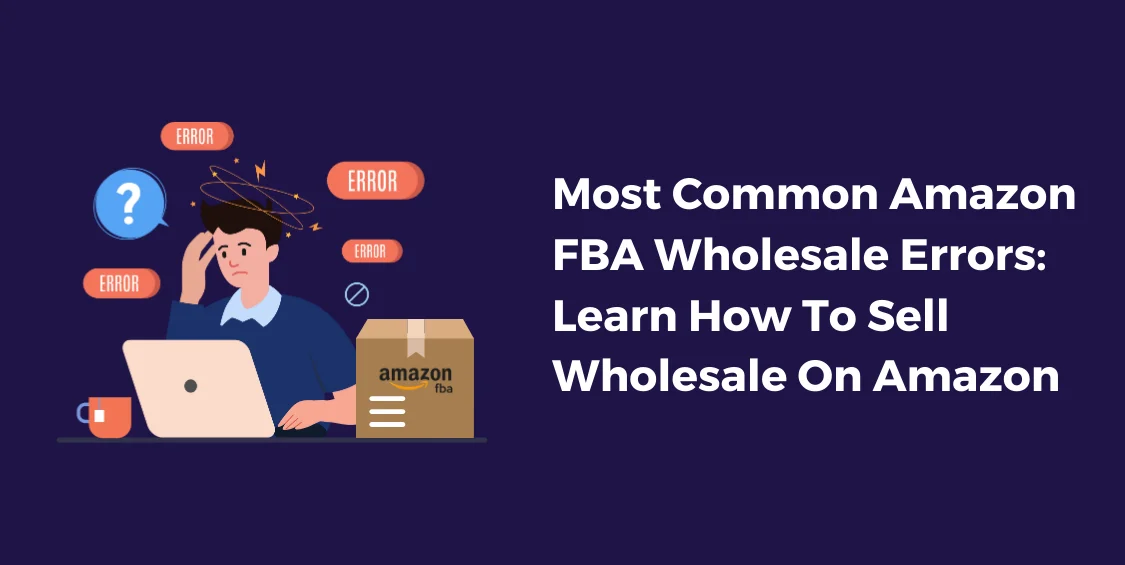Many Amazon sellers tried their luck, ditching their 9-5 jobs to experience the thrill of running their Amazon wholesale business and making six-figure profits.
However easy as it may sound, selling on Amazon is not a walk on rose petals. You may encounter various obstacles, ranging from your Amazon wholesale business needing more inventory to improper budget management for advertising.
But there is no need to brood over it, as we have you covered with a list of mistakes you can avoid for a smooth Amazon FBA Wholesale journey!
Blunder#01: Signing Up For Wrong Amazon Account

The first step to starting your Amazon FBA Wholesale seller journey is to sign up for an Amazon account as a professional or an individual. However, this is where most Amazon sellers need help choosing the correct account.
Sellers would choose individual seller accounts because it seems like a safe option, but they need to realize the limitation that comes with it: with an individual account, sellers can only go for 40 wholesale products to sell on Amazon.
If you target higher profits and aim for more than 40 wholesale products to sell on Amazon, research before choosing a seller’s account to begin your Amazon seller journey.
Blunder#02: Not Doing Thorough Product Research
It is not uncommon for sellers to pick a niche for their Amazon wholesale business without thorough research. They choose a niche and hastily pick the wholesale products to sell on Amazon that they believe are viable for their firm, eventually limiting their success potential. A prominent reason for their limited success rate is the high saturation in some niches of wholesale products on Amazon.
It will be challenging to go head-to-head with other players who are already years ahead of you with thousands of revenues and millions of revenues when starting from scratch.
Hence, we recommend that budding Amazon wholesale business owners steer clear of niches already highly saturated with top, well-established competitors.
Blunder#03: Fuddling Private Label Listings With Wholesale Listing


This is a rookie mistake, often becoming an expensive blunder at the beginning of their Amazon FBA Wholesale seller journey. New sellers looking for listings already selling on the platform often come across private-label listings with at least three sellers. A private label listing is an individual seller selling their products through that listing, while a wholesale listing has many sellers with three or more sellers selling the same product.
So before starting to sell wholesale products on Amazon, check the listing to see if the number of sellers must be more than three.
Blunder#04: Not Paying Attention To The Product Images

What is seen is sold! This is a quotidian mantra amongst marketers and sellers worldwide, yet many new sellers would ignore this crucial aspect when selling their wholesale products on Amazon—photos of blurry, undersaturated, or improperly cropped products put off shoppers. Not only do they discourage conversion and sales, but they also prevent customers from seeing essential product details.
We suggest sellers use a high-quality camera, a stable tripod, and a bright lightning source to capture close-to-real-life images. Edit the images to enhance the quality but not manipulate the product’s original features.
Blunder#05: Over-or Under-Pricing Products
Mispricing things is another typical blunder by Amazon merchants. Underpricing or overpricing can have a detrimental impact on your profit margin. Follow these steps to prevent this:
- Do an in-depth analysis of the industry and your rivals.
- Target the demographic you wish to sell your wholesale products on Amazon
- Add unique value to your wholesale products to sell on Amazon to make it stand out from the competitors.
- Think about the cost of the competition. Here, you price your goods by the costs of similar goods rivals businesses offer.
- When setting your selling prices, consider the Amazon FBA charges you’ll incur, such as storage, order processing, and shipping.
“Taking off on the Amazon Wholesale Business journey is like navigating a vast and challenging terrain, but with the right knowledge and strategies, you can turn these common mistakes into stepping stones to success.”
Blunder#06: Poorly Written Amazon Product Listing

Your product’s key feature is your sales pitch to convince the customer to try your product. Carelessly written vital features, including grammatical and spelling errors or misinformation about the product, will immediately put off any viewer and push them to your competitor.
To make your products trend, your Amazon product listings should shine with precise and accurate information about the product that enhances the customer’s experience of shopping in your store. If you fail to provide what customers seek in an Amazon product listing, don’t be surprised if your store has difficulty attracting daily traffic. Hire experts to ensure your listings comply with Amazon’s listing guidelines.
Blunder#07: Blindly Trusting The First Amazon FBA Wholesale Suppliers You Find
We cannot stress this enough but finding Amazon FBA wholesale suppliers to rely on is not a cakewalk for Amazon FBA Wholesale sellers. If you don’t do your due diligence on a vendor, you could pay extra or lose out on other opportunities. In addition, your loss could amount to thousands of dollars if a provider disappears with your deposit (the worst-case scenario).
So, to be safe, partner with Amazon FBA Wholesale suppliers that your competitors rely on. You can find these suppliers by entering your competitor’s name or an ASIN for one of their items to directly check who they contract with from the database.
Blunder#08: Not Satisfying Amazon’s Customer Support Standards
When it comes to happy customers, Amazon is quite picky. This is why it accepts A to Z claims from customers with little to no investigation. The fact that purchasers frequently need help to read all information presented to them compounds the issue.
Clear and easily accessible policy statements are required to meet Amazon FBA’s customer service standards.
It’s also important to remind customers why they should buy from you, to respond swiftly and politely to their inquiries, to fulfill their requests as soon as possible, and to never ask for praise. Amazon emphasizes the service quality provided by the sellers to their buyers and expects each seller to abide by its customer service guidelines to maintain its store performance rank.
Blunder#09: Not Optimizing Your Amazon Product Listings

Sellers new to Amazon wholesale business must realize how important it is to optimize their listings to make them conversion-ready. More than simply adding images and describing your product is required to get noticed by the customers. You need to compete with several competitors selling similar products, and the only way to stay competitive is to offer something more or embed relevant keywords in your listings.
Do your keyword research to realize the trending queries your target customers are searching for to rank your Amazon product listing to the top of Amazon’s search results. You may employ tools like Helium 10, SellerApp, Perpetua, AMZScout, and other Amazon tools for keyword analysis as per Amazon’s search engine. Hire advertising, and stock management professionals to boost your product’s sales on Amazon. Make the most of the platform’s potential with the help of efficient and effective optimization tools and methods.
Blunder#10: Overestimating Your Product Demand (Over-stocking)
Some Amazon wholesale business owners order massive amounts of stock without conducting thorough demand planning or analyzing anticipated sales.
As a result, having stock that sells slowly, you’ll have to pay more to keep it around. Items stored in an Amazon FBA warehouse for more than a year are subject to additional storage costs. Moving stock back to your storage space will save you on storage fees but will still cost money. The alternative is liquidation, although you will get back only some of what you put in in this case.
You can avoid this by relying on past data when determining how much stock to order and deliver into the Amazon FBA Wholesale Seller network.
Blunder#11: Not Having Enough Inventory (Under-stocking)

The opposite concern for Amazon sellers is running out of stock and losing sales. This scenario will likely happen when prices and demands are low during seasonal sales. Sellers may misinterpret their product’s demand and order less stock than they need.
As a result, going out of stock will move such listings to a lower Amazon ranking, less revenues, and even cost you your customer’s loyalty. Many Amazon sellers who can’t keep up with the high demand during sales seasons and don’t want to lose their store’s ranking and customer loyalty will put their accounts on hold till the end of the season.
Hire an inventory management expert from AMZDUDES to streamline your Amazon wholesale business’ fulfillment and logistics.
To Sum It All Up,
You can save time and money in the long run by considering these typical Amazon FBA selling blunders. We’d be happy to address any more questions regarding Amazon wholesale business, so please don’t hesitate to contact us.
If you wish to discuss further queries concerning your Amazon FBA wholesale business, don’t hesitate to talk to our seasoned eCommerce experts at AMZDUDES. Get in touch with us today!





